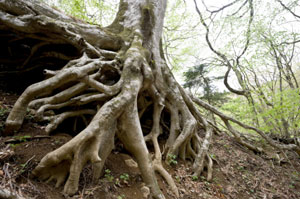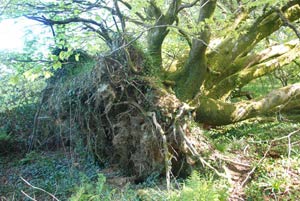Trees and Roots
Normally, the first structure to emerge from a seed is the embryonic root - the radicle. This grows downwards (in search of water and nutrients) as the primary or tap root. In most plants, this primary root will develop secondary or lateral roots that grow out away from the main root, as the seedling grows. The growth of any root is dependent on a small ball of dividing cells just behind the root tip. This collection of cells is called a meristem; it generates new cells to extend the root and form new root tissues (such as the xylem and phloem – the conducting tissues).
Different species have different patterns of root growth, though some are perhaps more flexible or varied than others. The Scots pine in its first year forms a noticeable primary root and a significant number of secondary and tertiary (lateral) roots. A long tap root may develop in suitable soils, whilst, in sandy or peaty soils, the lateral roots may dominate. A number of studies indicate the dominance of the young tap root is often lost quite early in development in many tree species. The deepest root systems are probably to be found in desert plants.
 Tree roots do not (in general) occur in great amounts at any significant depth. The majority of a tree's roots occur in the top 1 - 2 metres of the soil; trees tend to have shallow but extensive root systems. The spread of lateral roots can be as great as the spread of the canopy or crown, or even beyond in some cases. One study showed that the root spread of poplar was greater than three times the crown radius. Root systems such as this are sometimes referred to as extensive systems. An intensive root system is one that is confined to a smaller soil volume, relying on shorter laterals, which have numerous fine endings. Such a system may be seen in beech (Fagus sylvatica). Beech was one of the tree species that suffered more than most in the drought of 1976 (though it can penetrate to great depths of some soils).
Tree roots do not (in general) occur in great amounts at any significant depth. The majority of a tree's roots occur in the top 1 - 2 metres of the soil; trees tend to have shallow but extensive root systems. The spread of lateral roots can be as great as the spread of the canopy or crown, or even beyond in some cases. One study showed that the root spread of poplar was greater than three times the crown radius. Root systems such as this are sometimes referred to as extensive systems. An intensive root system is one that is confined to a smaller soil volume, relying on shorter laterals, which have numerous fine endings. Such a system may be seen in beech (Fagus sylvatica). Beech was one of the tree species that suffered more than most in the drought of 1976 (though it can penetrate to great depths of some soils).
Surveys of trees blown over in the October 1987 storm indicated that only 2 - 3% had distinct tap roots. Oak, pine and silver fir are amongst those that may have persistent tap roots. Other species have what are termed 'heart root systems' where larger and smaller roots penetrate the soil diagonally from the main trunk. Trees such as larch, lime and birch can fall into this category.
 A surface root system is one where the roots tend to run horizontally just below the soil surface, with some roots descending deeper and vertically into the soil. Ash, aspen and Norway spruce can provide examples of this. However, there is no clear or simple classification of root systems. Much depends on local geology, soil type, climate, drainage etc. So, for example, water logging of the soil will limit gas exchange, which will affect the oxygen the root can get for respiration – which generates energy for growth and the take up of minerals. When the oxygen level in the soil falls, root growth is reduced or stopped completely. The availability of oxygen can also be reduced by compaction of the soil. More information of plant roots can be found in The Forestry Commission's interesting and comprehensive downloadable pdf on The influence of soils and species on root depth .
A surface root system is one where the roots tend to run horizontally just below the soil surface, with some roots descending deeper and vertically into the soil. Ash, aspen and Norway spruce can provide examples of this. However, there is no clear or simple classification of root systems. Much depends on local geology, soil type, climate, drainage etc. So, for example, water logging of the soil will limit gas exchange, which will affect the oxygen the root can get for respiration – which generates energy for growth and the take up of minerals. When the oxygen level in the soil falls, root growth is reduced or stopped completely. The availability of oxygen can also be reduced by compaction of the soil. More information of plant roots can be found in The Forestry Commission's interesting and comprehensive downloadable pdf on The influence of soils and species on root depth .
Comments are closed for this post.
Discussion
Like your site. Hope you can help me save my Stone Pine .
I need info on its roots as insurers say it must be removed due to draining clay soil of water .
Have no specific practical knowledge about the root system of Norway Spruce.
But a quick google reveals a lot of information out there
For example :
https://dissertationesforestales.fi/pdf/article1907.pdf
https://www.norwayspruce.com
http://hort.ufl.edu/database/documents/pdf/tree_fact_sheets/picabia.pdf
https://www.windbreaktrees.com/norway.html
Hi, I have a question about the root system of Norway Spruce.
I’ve been told the tap root of a Norway spruce can go as deep as the height of the tree. I have 80 foot Norway Spruce, and I’m trying to figure out the stability of the tree.
I’ve been told the Spuce is more likely to snap than uproot because it’s anchored by the deep tap root. I wondered if I can get your thoughts on the Spruce root system. Thank you very much!
I like your site
Biotechnology although a comparitively new field, yet to my observations. The plants with deep and seccondary root system can change the mineral contents of the soil as they normally absorb all the other minerals except gold over the life of the plants. The plants even absorb platinum. So this quality can be used for concentation of gold in “Gold Bearing Ores”

We cannot comment on insurance / legal matters.
Blogs
14 October, 2022